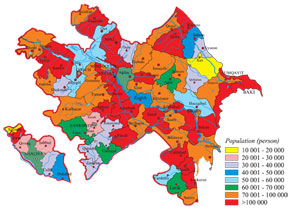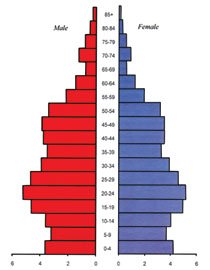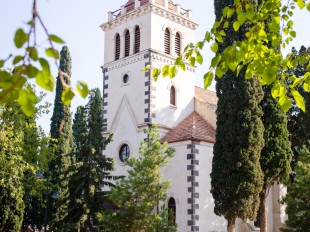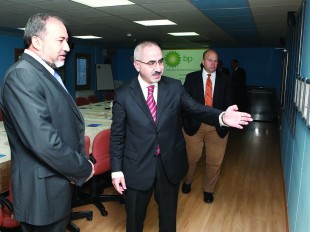 Population distribution in the Azerbaijan Republic. Source: Demographic Indicators of Azerbaijan. Baku, 2011
Population distribution in the Azerbaijan Republic. Source: Demographic Indicators of Azerbaijan. Baku, 2011 by Karim Shukurov
Population statistics
The main sources for a demographic study of a nation are its population statistics. During the Soviet period (1920-1991) the population figures for Azerbaijan were, of course, included in the vital statistics of the USSR. After the declaration of state independence (18 October 1991) and the collapse of the USSR (18 December 1991) the country’s national statistics were gradually developed in accordance with world standards. These figures now record population reproduction and migration, the census, estimates and forecasts. The general censuses carried out in 1999 and 2009 should be noted as great successes in accumulating information about the population.
The statistics are published in specialist journals and magazines: the annual Demographic Indicators in Azerbaijan, Women and Men in Azerbaijan, Youth in Azerbaijan and Children in Azerbaijan. The results of the population censuses of 1999 and 2009 were also published. Population information is also central to the Statistical Yearbooks of Azerbaijan. These materials help to form an overall picture of the demographic situation in Azerbaijan over the years of Independence.
The Karabakh war and the population of Azerbaijan
In all historical periods wars have occasioned demographic calamity. Armenia’s territorial claims on Azerbaijan since 1988 and their transformation into military operations caused one of the most severe demo-graphic calamities in modern history. All the Azerbaijanis living in Armenia were deported in a very short period of time. 50,149 families (243,628 people) had to leave their historical lands in Armenia and flee to Azerbaijan. Later, as a result of the occupation of the Nagorno-Karabakh region and the seven surrounding districts, 146,455 families (611,293 people), as well as 20,678 families (86,386 people) from regions bordering the occupied districts, left their native lands. Approximate calculations suggest that more than 30,000 Azerbaijanis were killed by Armenian armed forces during the Karabakh war. Thus, territorial claims raised by Armenia against Azerbaijan and the Karabakh war dealt a severe blow to the natural historical development of the country’s demography.
The transition from the planned economy of the Soviet era to a free market economy, the development of new property relations, changes to the socio-psychological environment established over decades and other factors on top of the war, increased the pressure. The situation demand-ed a substantial state policy in response.
Demographic policy
In December 1999, a Concept for the Demographic Development of the Republic of Azerbaijan was adopted. An assessment of the situation prevailing in the 1990s was correctly highlighted as the first step to be taken. It became clear that the main demographic indicators had deteriorated considerably over the period: mortality rates had risen and birth rates had fallen. Child and maternal mortality were among the worst affected. The official statistics for 1997 recorded a rate of infant mortality of 19.6 per thousand while information from United Nations sources indicated a figure of 33 per mille. Maternal mortality rose by a factor of 3.3 between 1990 and 1997. Other negative trends appeared in the figures for marriage and divorce. Thus, between 1991 and 1997, the number of marriages declined from 74,000 to 47,000, a fall of 36.8 per cent. Of CIS countries, Azerbaijan had one of the highest numbers of single people in the 25-29 age group without the opportunity to marry. At the same time births outside marriage increased by a factor of 2.8 from 1990-1997, from 2.6 percent to 7.3 percent of births etc.
In the face of such negative demographic trends in the first years of Independence, crucial measures were mapped out. The priority for the long-term development strategy was to ensure quantitative and qualita-tive growth in the population by eliminating these trends.
Main trends in the modern demographic context
Population numbers and composition
The formulation of demographic policy and measures appropriate to the real situation effected some changes in the first decade of the 21st century. While on the eve of independence (1991) there were 7,218,500 people in the Republic, by 2000 the number had reached 8,032,800.
In 2001, population growth fell from 81,500 to 77,100, but rose again the following year. From 2005, annual growth exceeded 100,000, reaching 117,100 in 2008. In 2011, Azerbaijan’s population was 9,111,100, an increase of 1,892,600 over the figure for 1991. Interestingly, despite fluc-tuations in population over the period of independence, the urban and rural populations maintained approximately the same ratio (53:47).
Although the population of the Nakhchivan Autonomous Republic of Azerbaijan underwent certain changes between 1991 and 2011, development continued. Nakhchivan’s population rose from 307,200 in 1991 to 410,100 in 2011. The ratio of urban to rural populations differed from that of the Republic as a whole (29:71) but also remained stable over the period.
The age and sex composition of the population is highly significant to the country’s demography. The main tendency in the first decade of the 21st century was growth in the number of males. In 2011, the ratio of males to females was 49.6:50.4; there were 1017 females per 1,000 males. A human factor may be significant in determining the ratio of males to females. The possibility of ascertaining the sex of children in the mother’s womb may have led to the prevention of female births by artificial means.Some new trends in the age composition of the population have also appeared. Thus, compared with the early 1990s, numbers in the age groups 0-4, 5-9 and 10-14 have fallen and there are more people aged 70 and over. However, people under 34 years old constitute 60 per cent of the total population; in other words, the population is still considered to be a young one.
 Population structure by age and sex in the Azerbaijan Republic at 1 January 2011. Source: Demographic Indicators of Azerbaijan. Baku, 2011
Population structure by age and sex in the Azerbaijan Republic at 1 January 2011. Source: Demographic Indicators of Azerbaijan. Baku, 2011 Natural growth of population
Azerbaijan has historically had a high birth rate, but this has declined since the end of the 1960s. The downward trend continued until the be-ginning of 2000 and then began to rise again. In 2010, the birth rate was 18.5 per thousand. The mortality rate rose in the early 1990s (from 1992 to 1994, 7.1-7.3 per thousand), due largely to the Karabakh war, but then began to fall again. In 2010, the number of deaths per 1,000 people was 6.0.
Changes to the birth and death rates were reflected in population development. Natural growth dropped from 25.3 per thousand in 1991 to 11.2 per thousand in 2010.
Demographic processes are mainly related to birth rates. However, the study of mortality also allows us to answer a number of questions. The question What is the main cause of death? raises many important issues. Thus, if respiratory diseases etc. are significant causes of death then it follows that there are serious health problems in that country. Increases in the number of tumours and problems in the circulatory system indicate a more modern cause of death.
Investigations into the causes of death in Azerbaijan show that the number of deaths from diseases of the respiratory system, as well as from injury, poisoning and other external causes has fallen significantly. While 88.3 deaths per 100,000 people were caused by diseases of the respira-tory system in 1991, in 2010 this number had fallen to 26.6. The number of deaths from injury, poisoning and other external causes were 46.4 and 28.3 respectively. In contrast with these figures, the number of deaths from tumours and circulatory system problems has increased. So, there is a trend towards more modern causes of death and this should be taken into account in the organization of health care.
A gradual decline in mortality rates for infants up to 1-year-old is one of the most important trends in the republic’s demographic situation. While there were 25 per thousand in 1991, by 2010 this number had fallen to 11.2. A comparison of infant mortality in urban and rural areas produces interesting results. In 1991, mortality rates for infants up to 1-year-old in urban and rural areas were 21.5 and 28.7 per thousand respectively i.e., the figure was higher in rural areas. However, in 2010 mortality rates for infants up to 1-year-old were 14.5 per thousand in urban areas and 8.1 in rural areas, i.e. this number was higher in urban areas. Thus measures for the reduction of infant mortality in rural areas had been more effective.
Marriage and divorce
The Azerbaijan family is a strong institution and relatives have very firm ties. The structure of the Soviet Union and the emergence of new economic relations after its collapse had an influence on family and mar-riage relationships but could not undermine them. In the late 1990s and the beginning of 2000 there was a sharp decline in the number of marriages per 1000 population; the low point was 1999 with 4.8 per thou-sand. However, from the middle of 2000 the number of marriages rose again. In 2006 there were 9.4 marriages per 1,000 people, in 2007 - 9.5, in 2008 - 9.2 and in 2010 the figure was 8.9 per thousand.
The increase in divorce rates began a gradual decline at the end of the Soviet period and in the first years of Independence: there were 19 per thousand in 2010.
Migration: more arriving or more leaving?
The most significant changes to the demographic situation in the period of independence occurred in migration. The ‘Barrack Socialism’ that existed in the USSR was designed to prevent migration abroad. The situ-ation changed with the collapse of the Soviet Union. Both arrivals and departures increased considerably. Throughout history Azerbaijanis have been distinguished by their close attachment to their native land. How-ever, the new historical conditions gave rise to a surge in migration and an Azerbaijani Diaspora has been established in a number of countries.
In the early years of independence the numbers of those leaving the country for permanent residence outstripped the numbers of arrivals. However, people arriving for permanent residence in Azerbaijan gradu-ally began to overtake the number of emigrants. Thus in 2010, 2,200 people arrived to establish permanent residence, while 800 left the country.
Thus a specific demographic situation has developed in the Republic of Azerbaijan during the period of independence and new trends established alongside the traditions.
Literature
1. Concept for the Demographic Development of the Republic of Azerbaijan // Collected Legislation of the Republic of Azerbaijan, 1999, No 12, pp.2921-2927
2.Children in Azerbaijan. Statistical yearbook. Baku, 2011
3. Demographic Indicators in Azerbaijan. Statistical yearbook. Baku, 2011
4. Statistical Yearbook of Azerbaijan. Baku, 2011
5. Women and Men in Azerbaijan. Baku, 2011
6. Youth in Azerbaijan. Statistical publication. Baku, 2011


